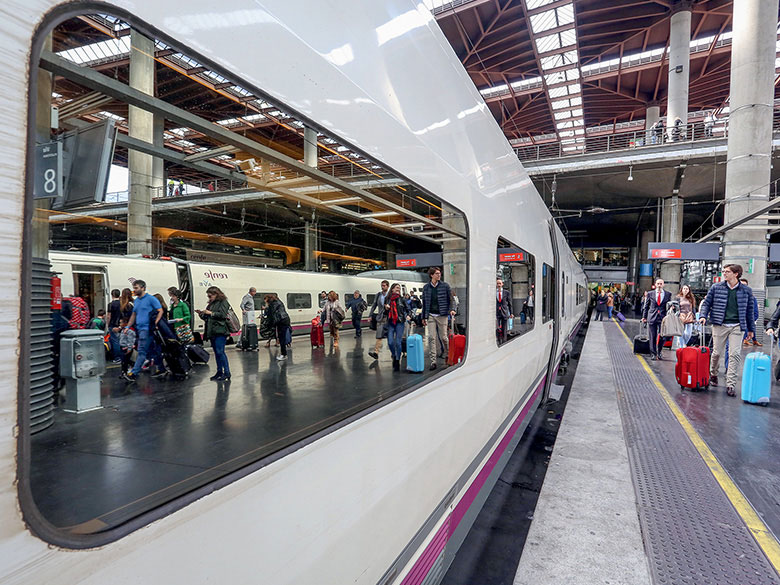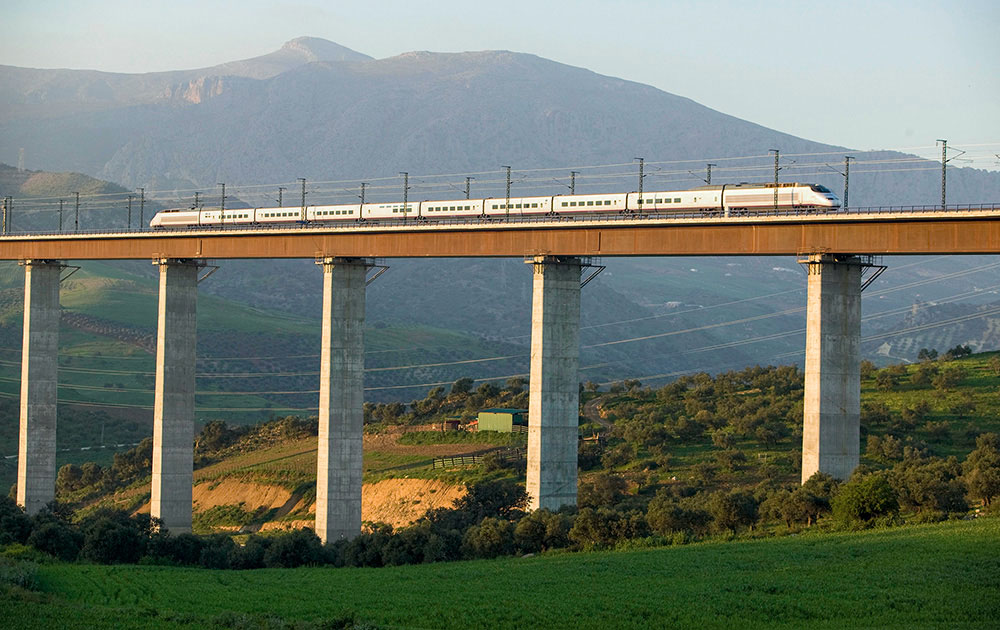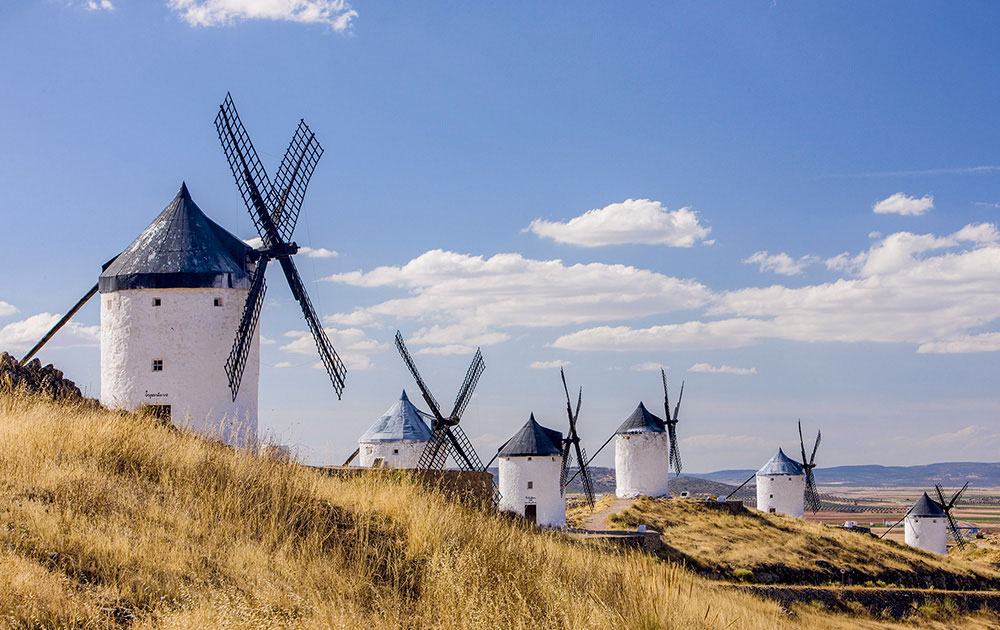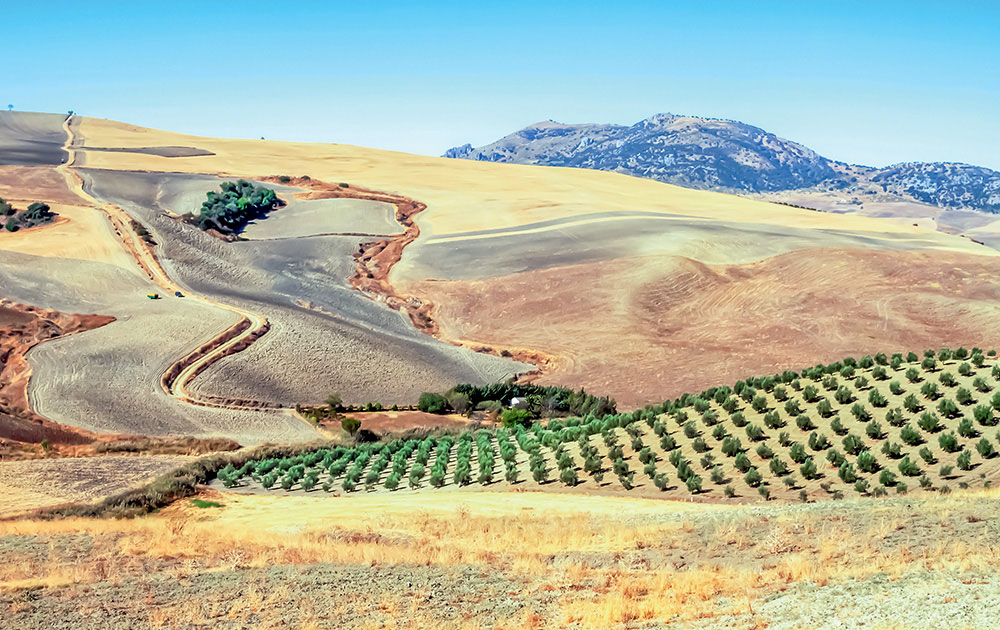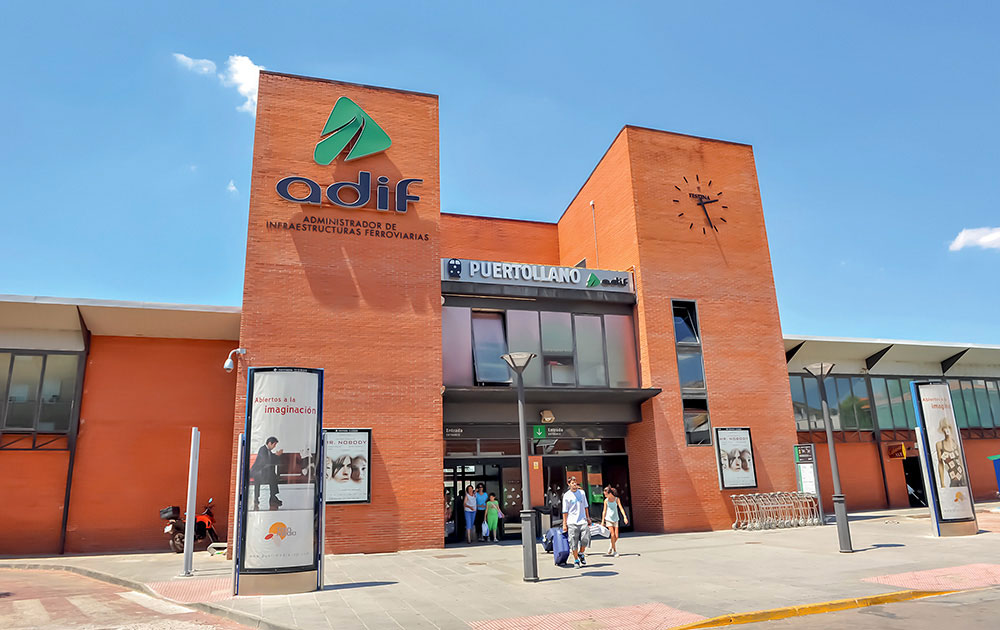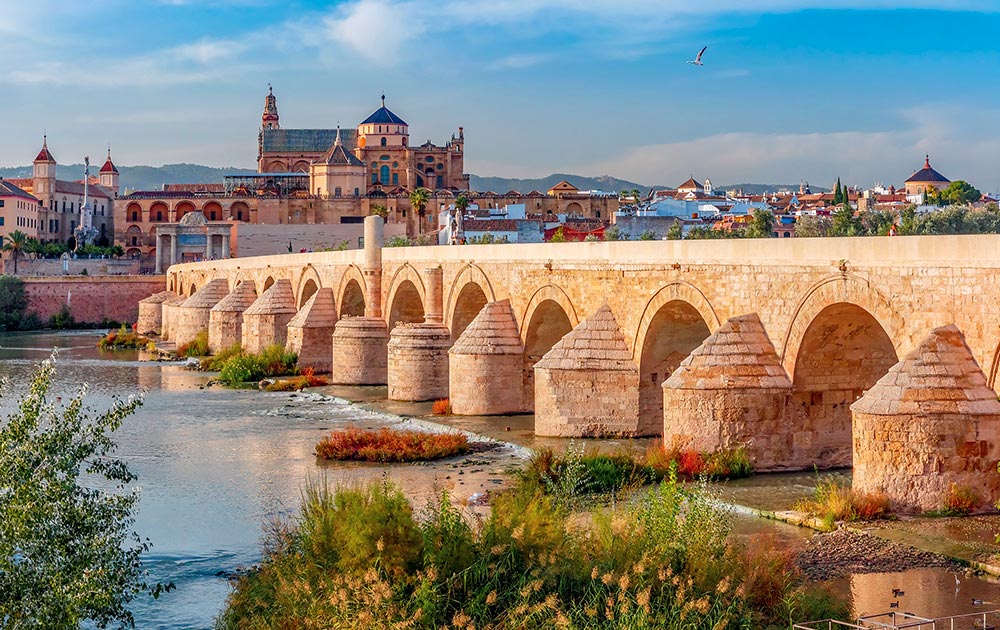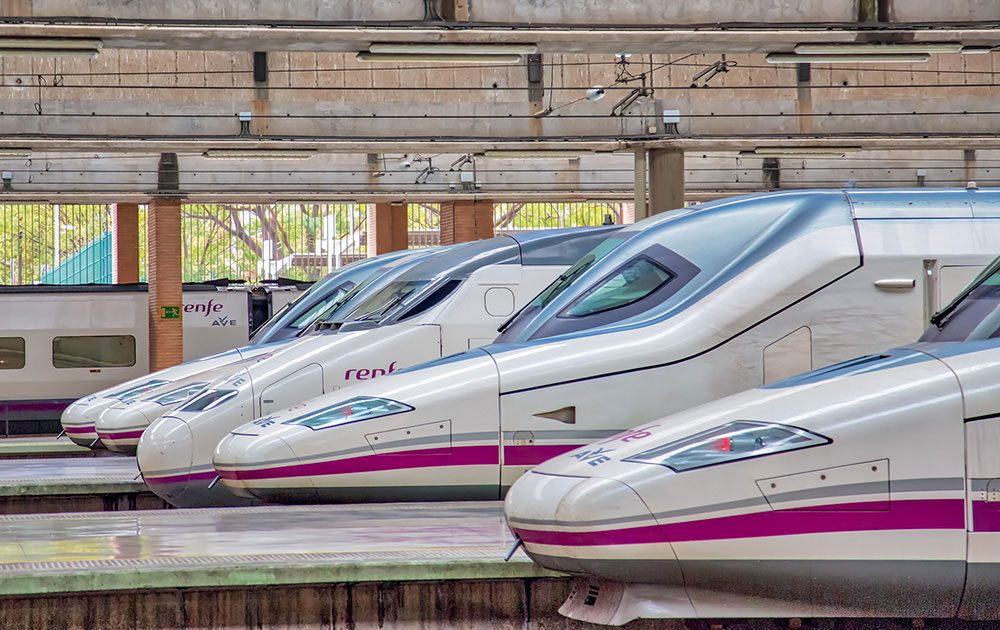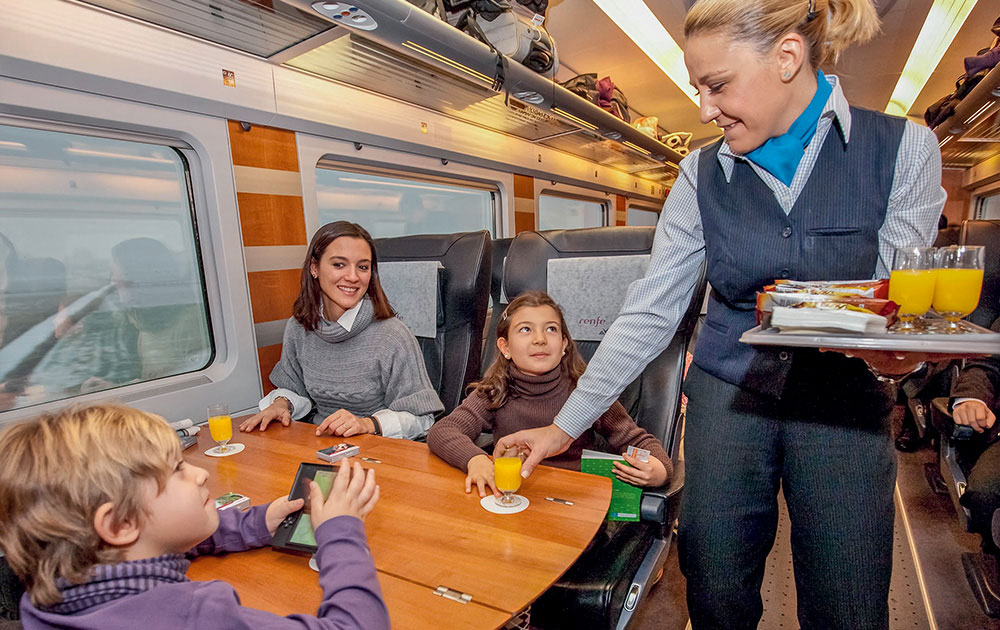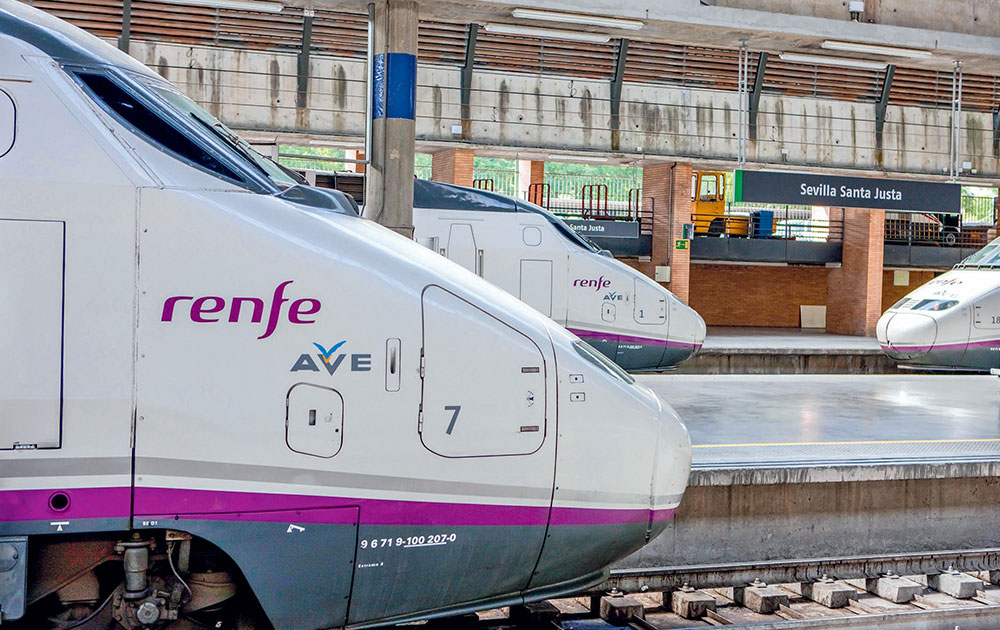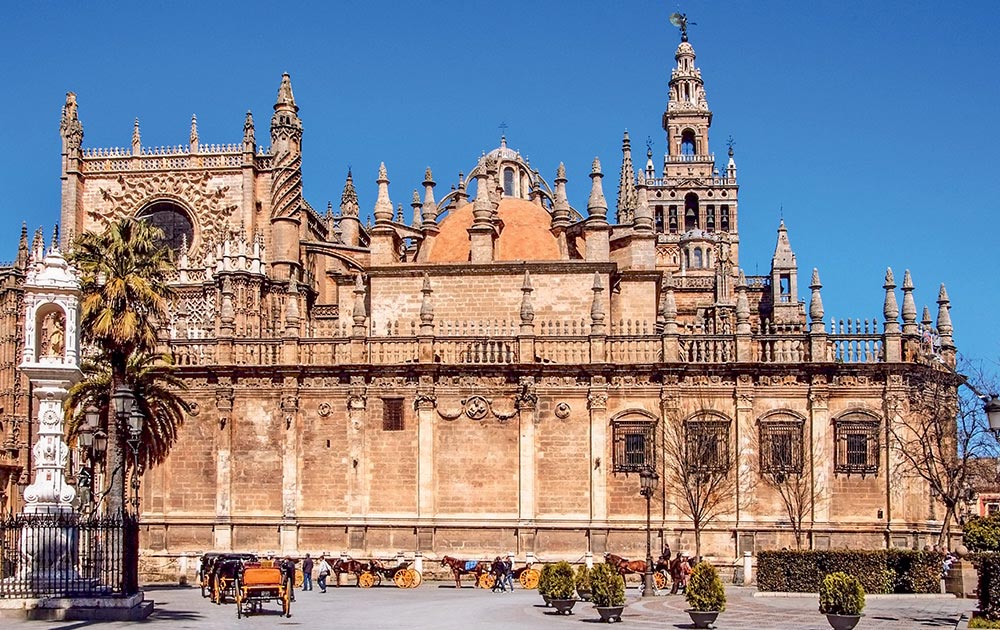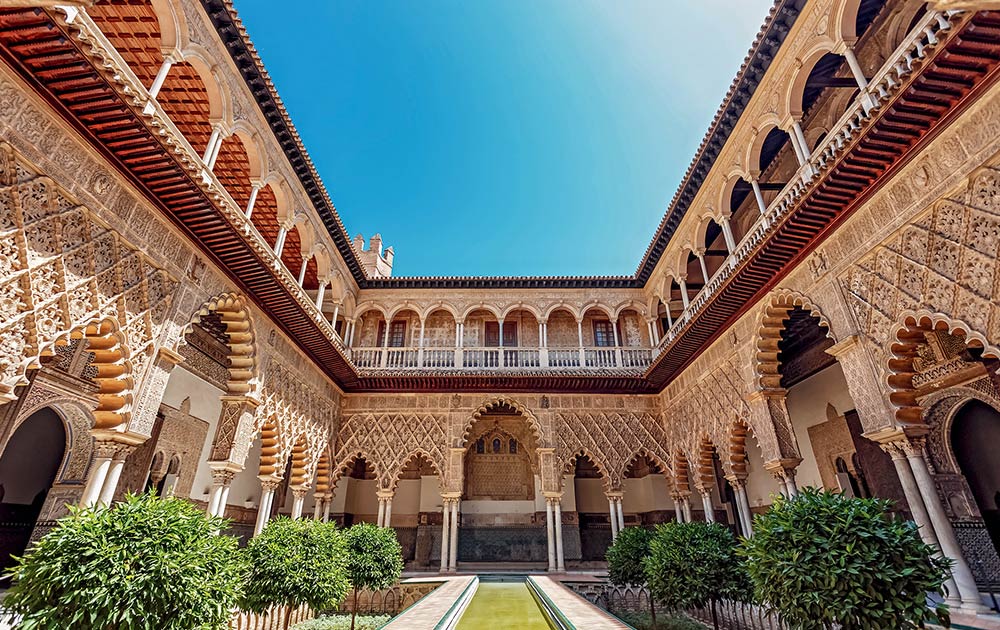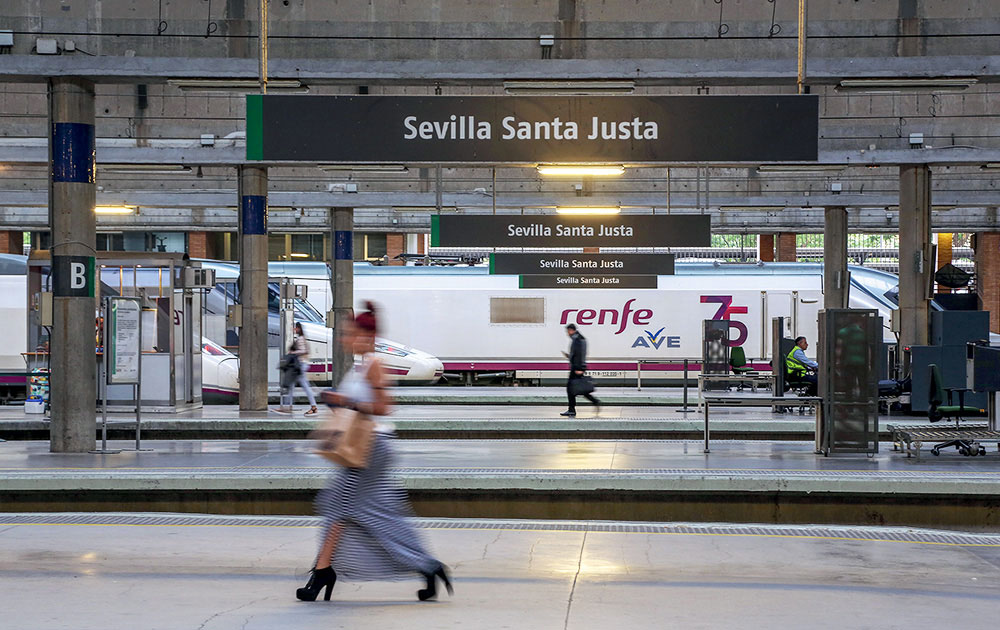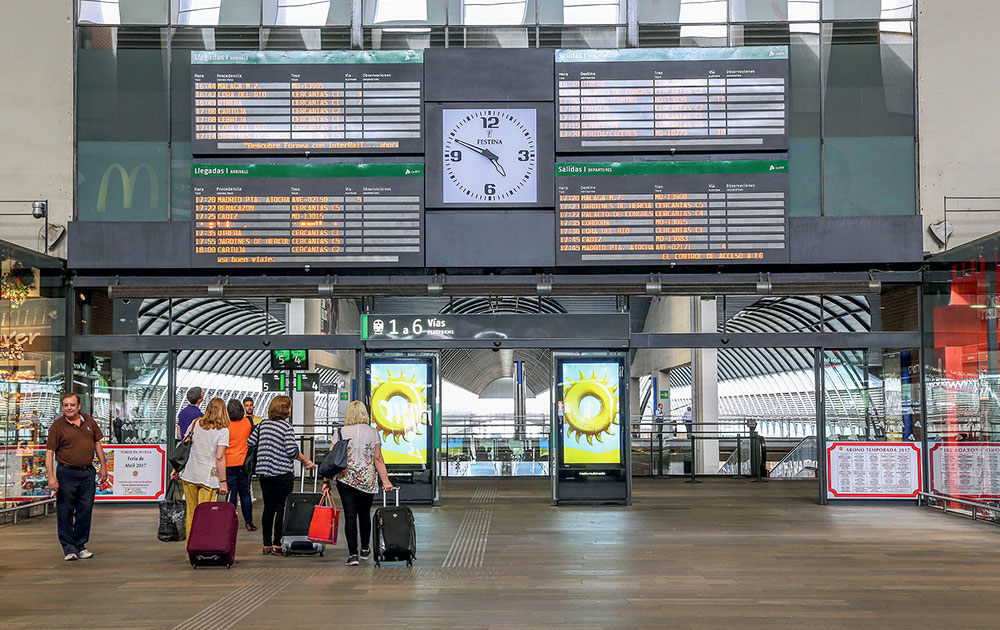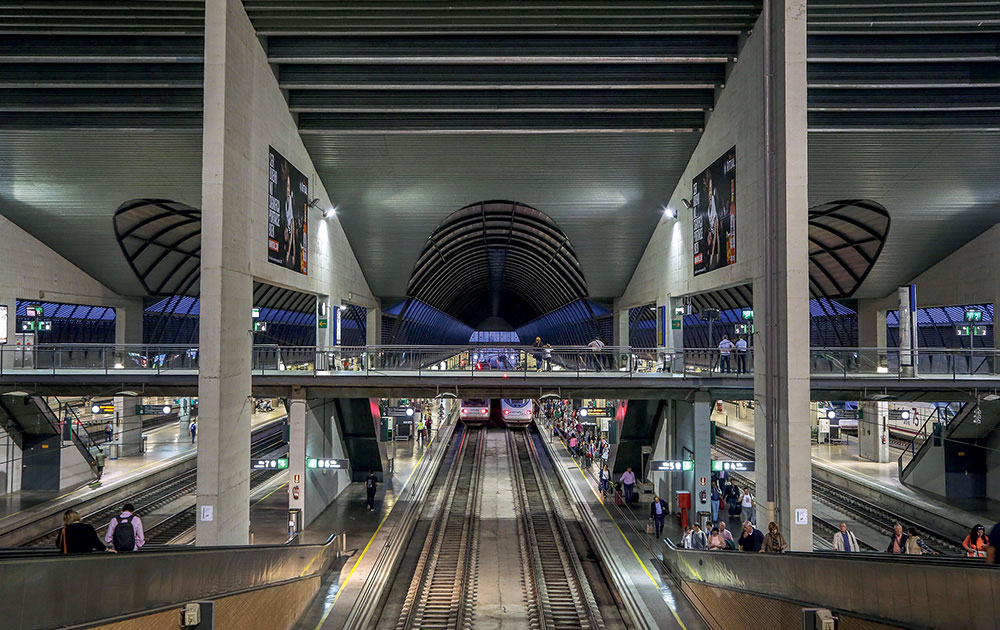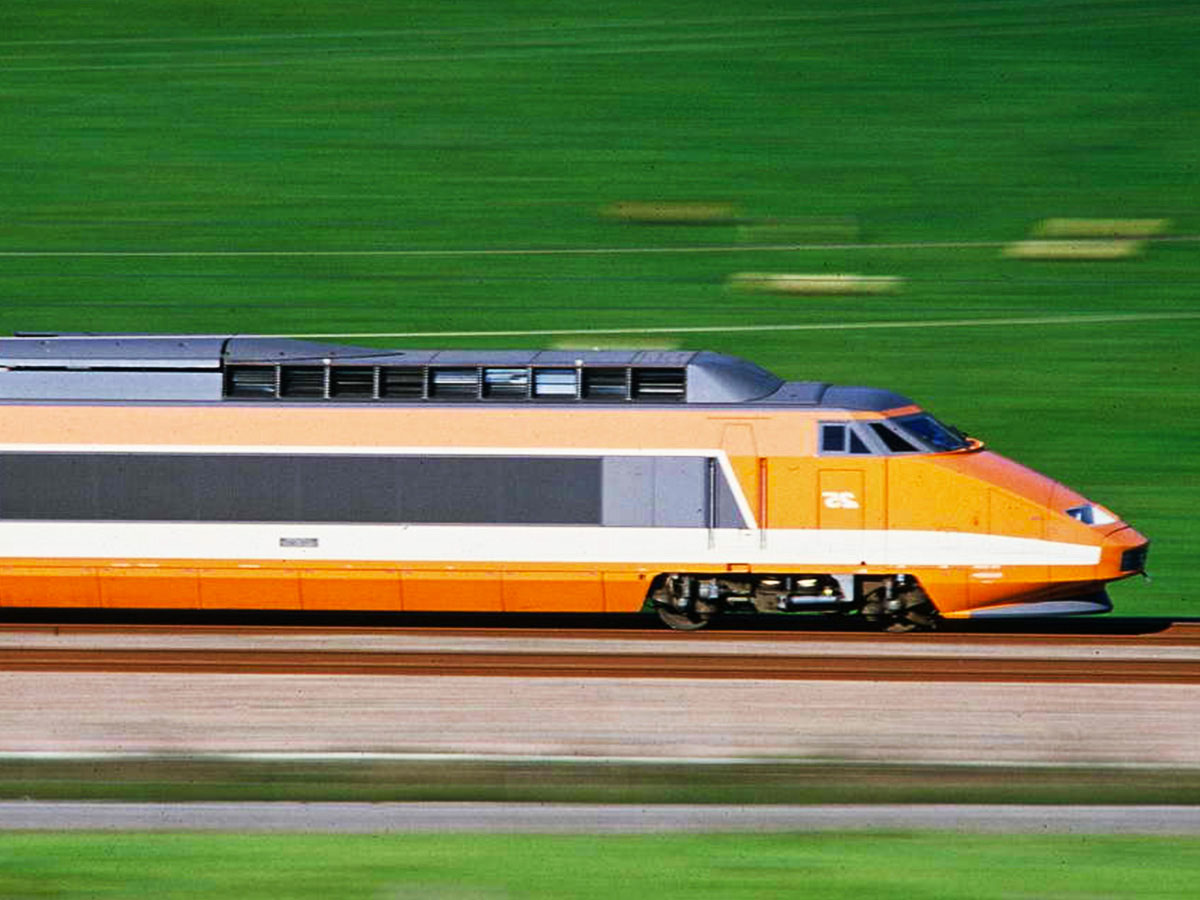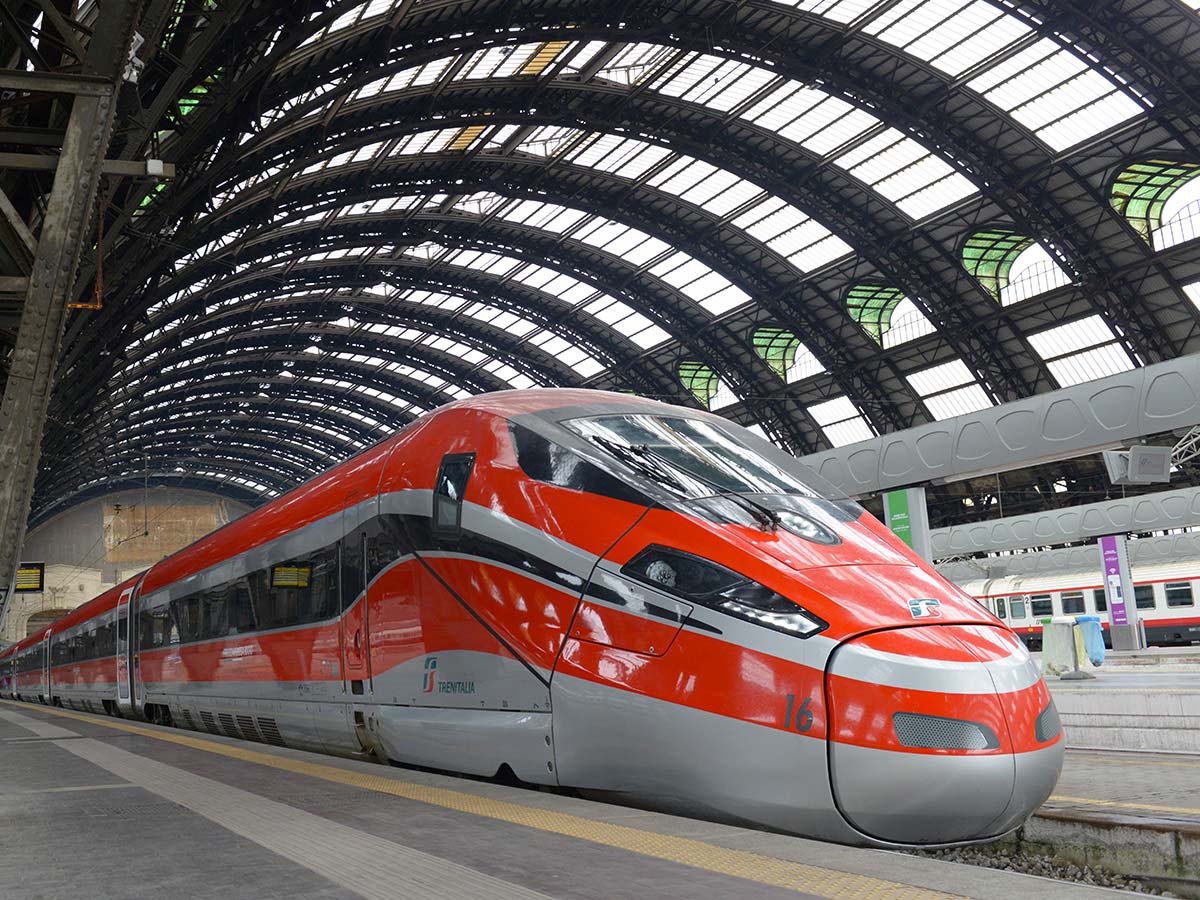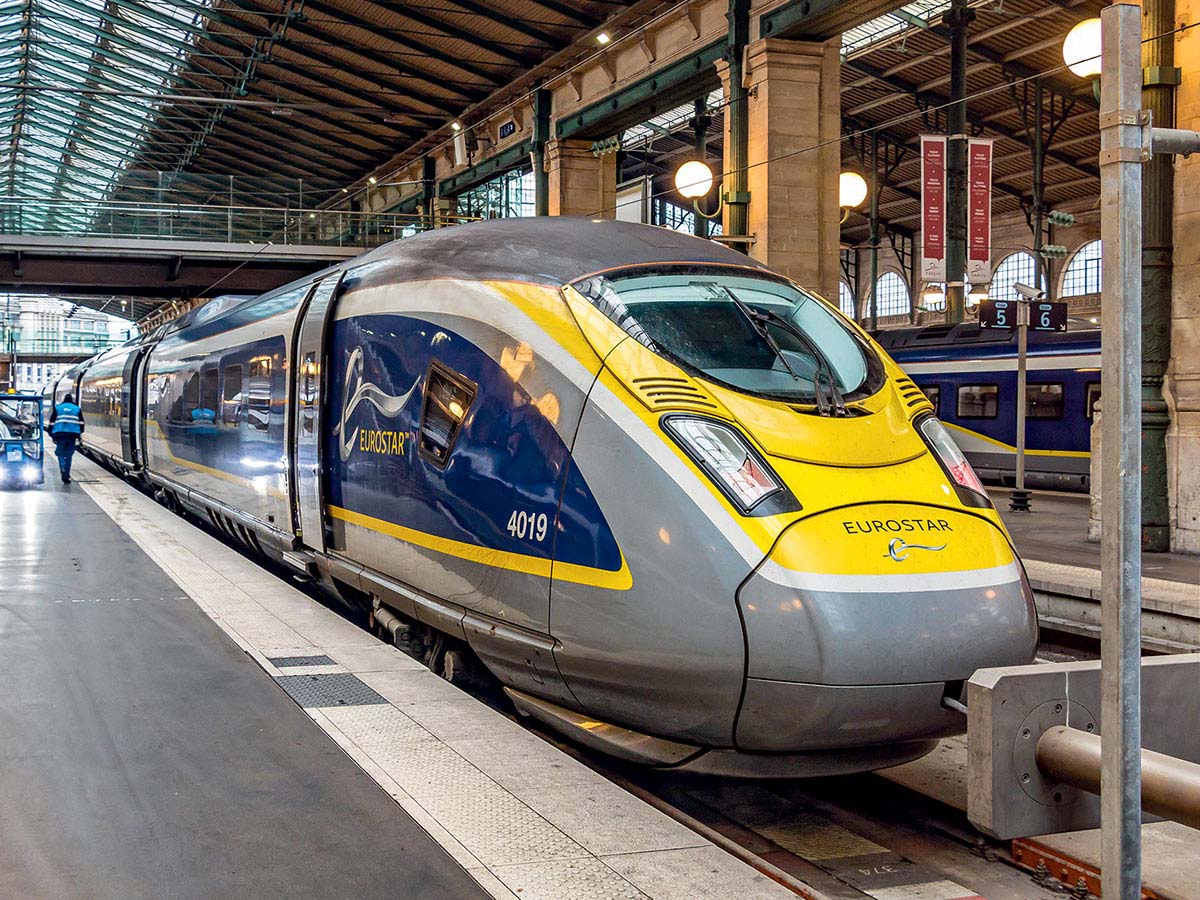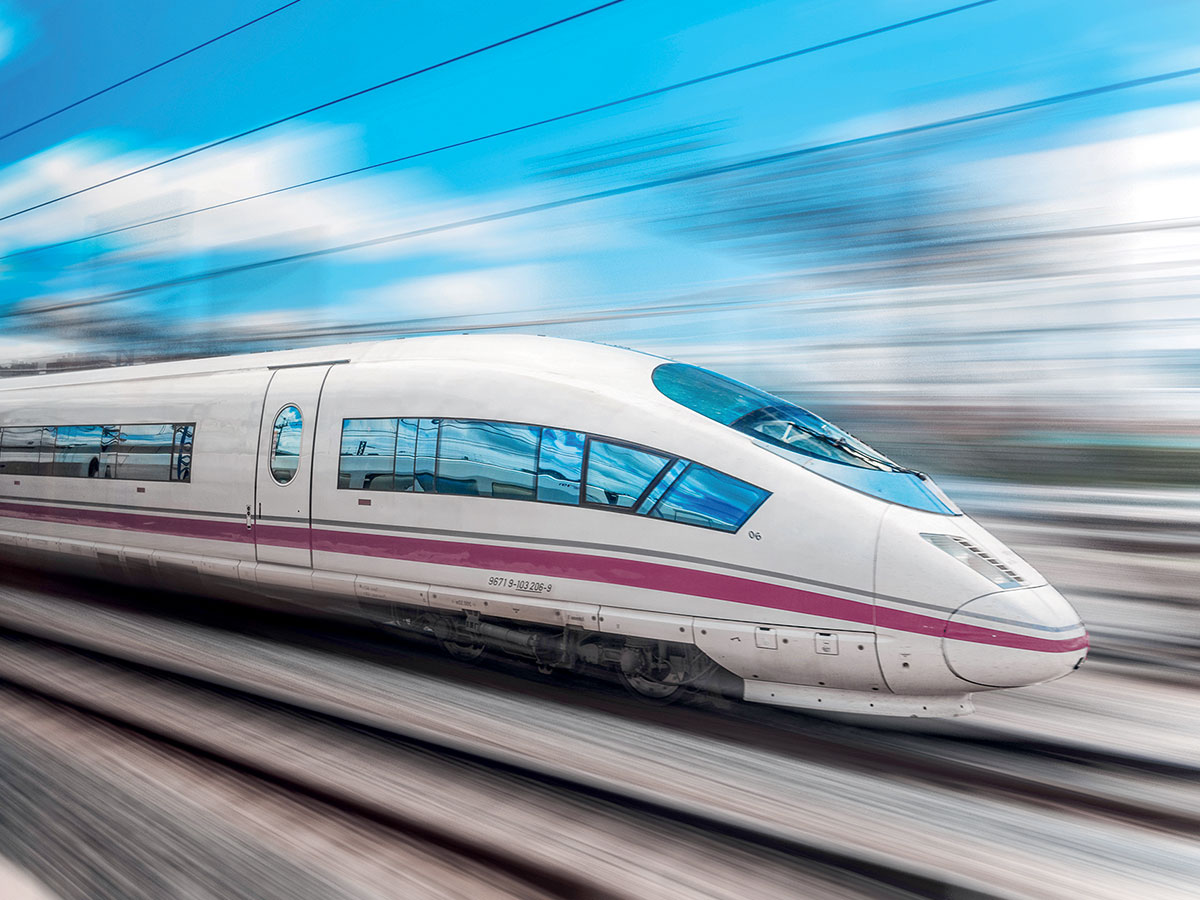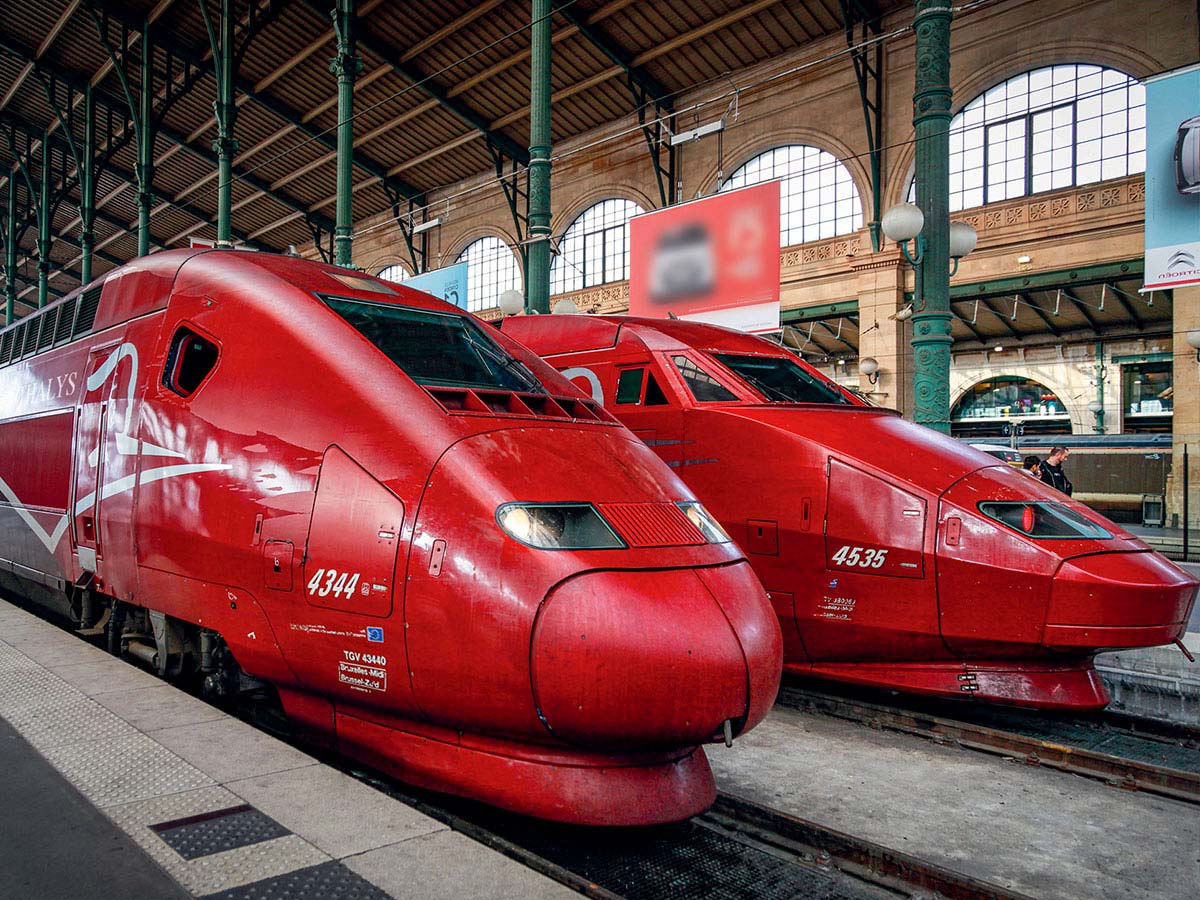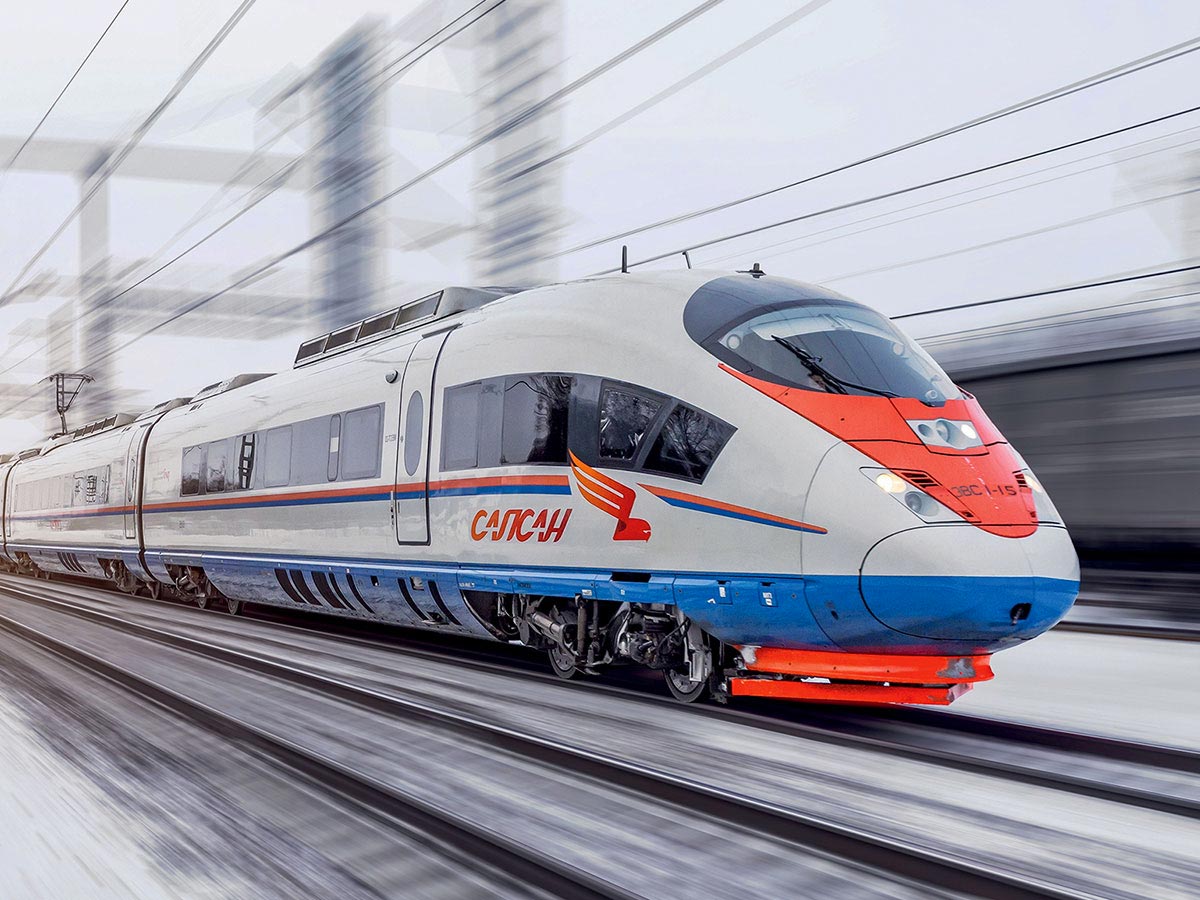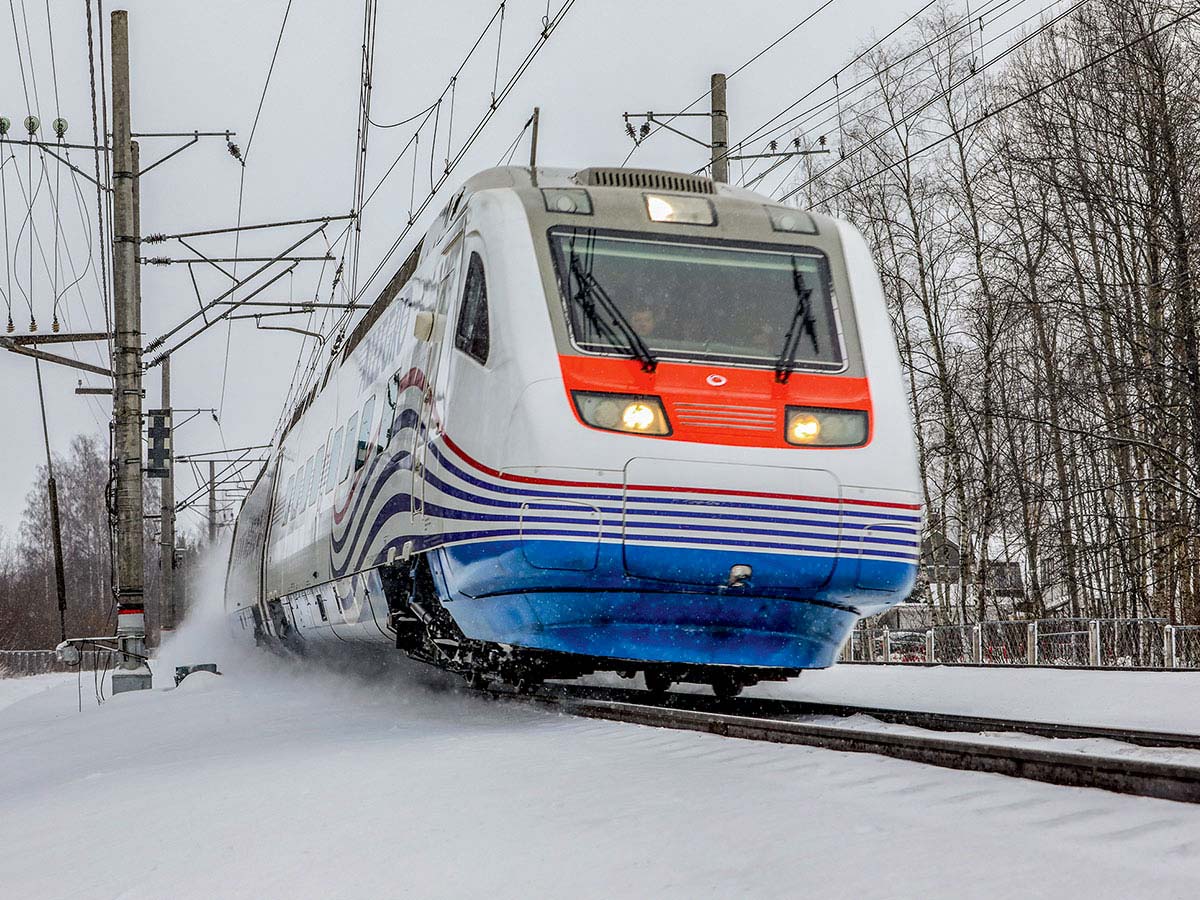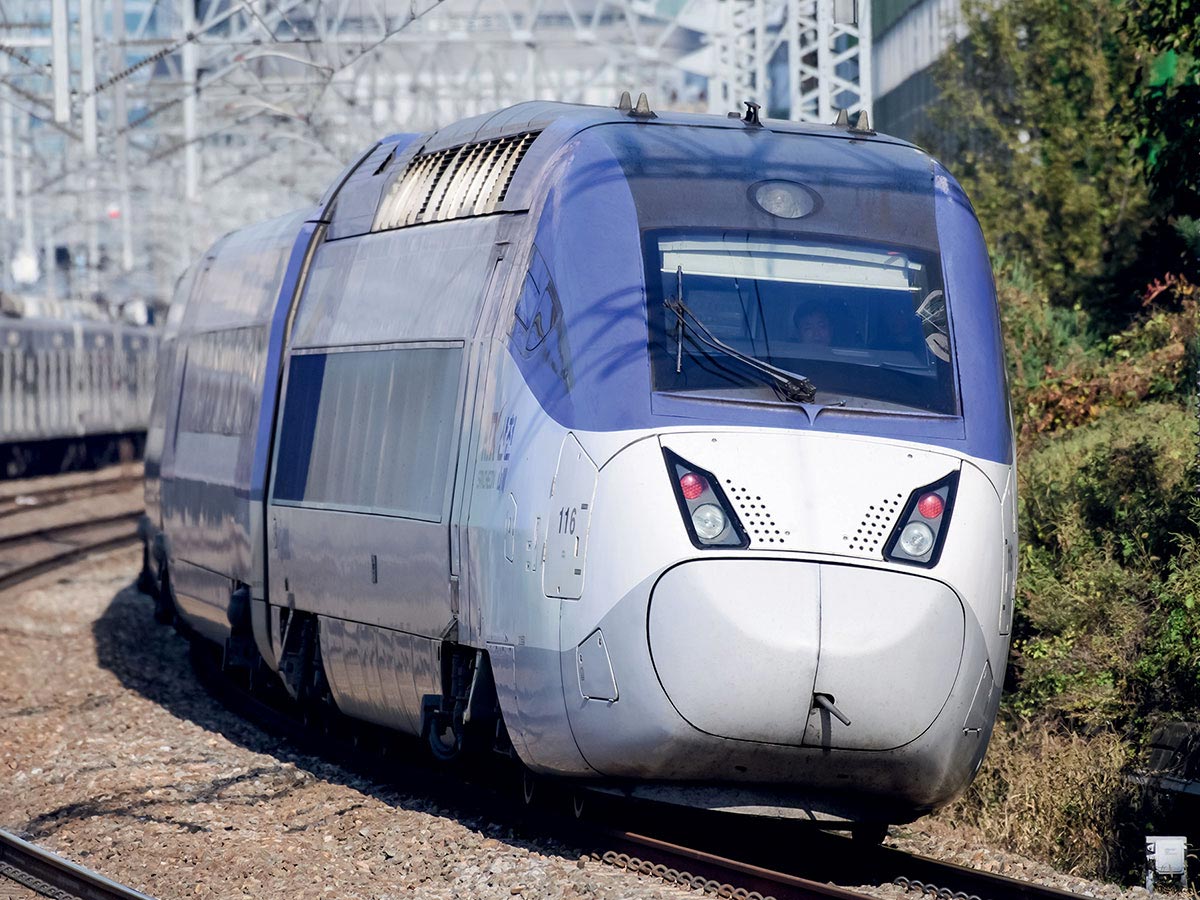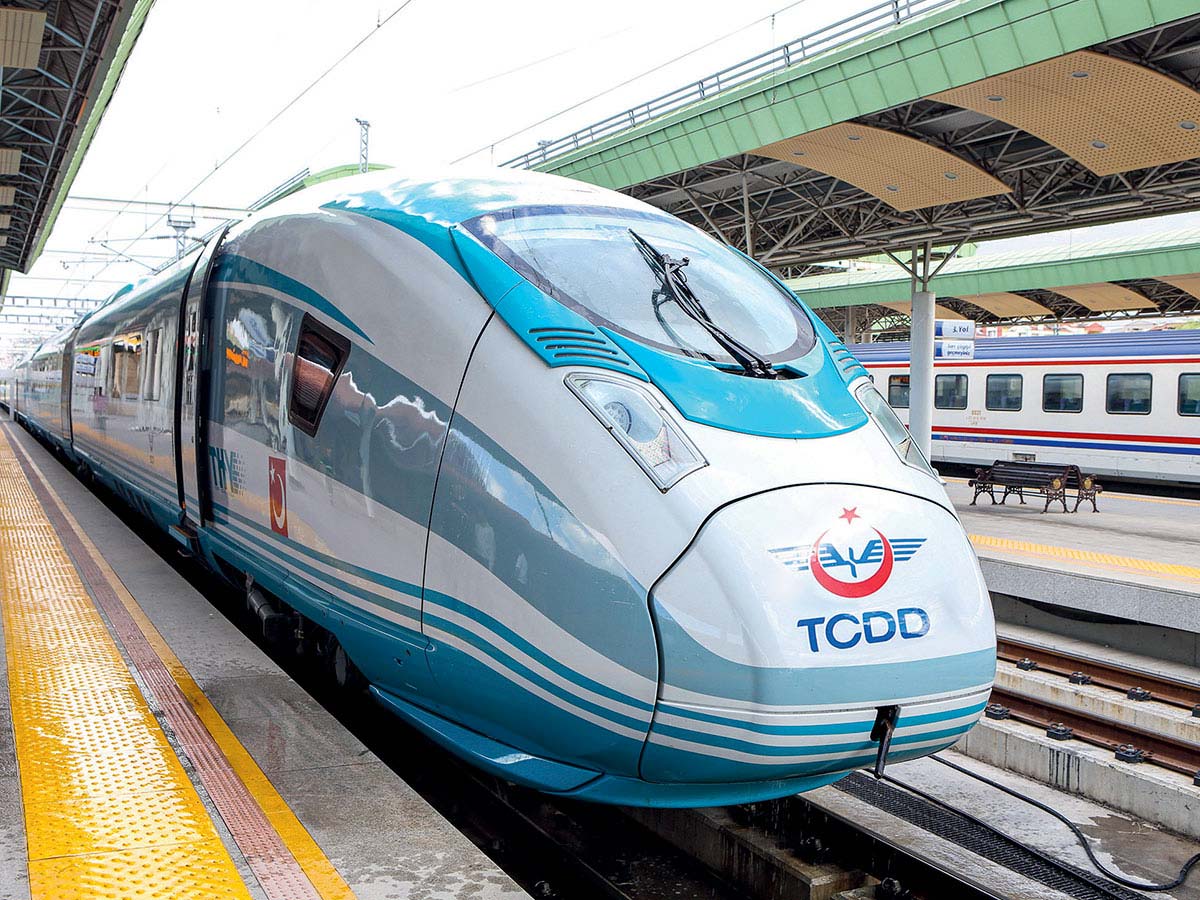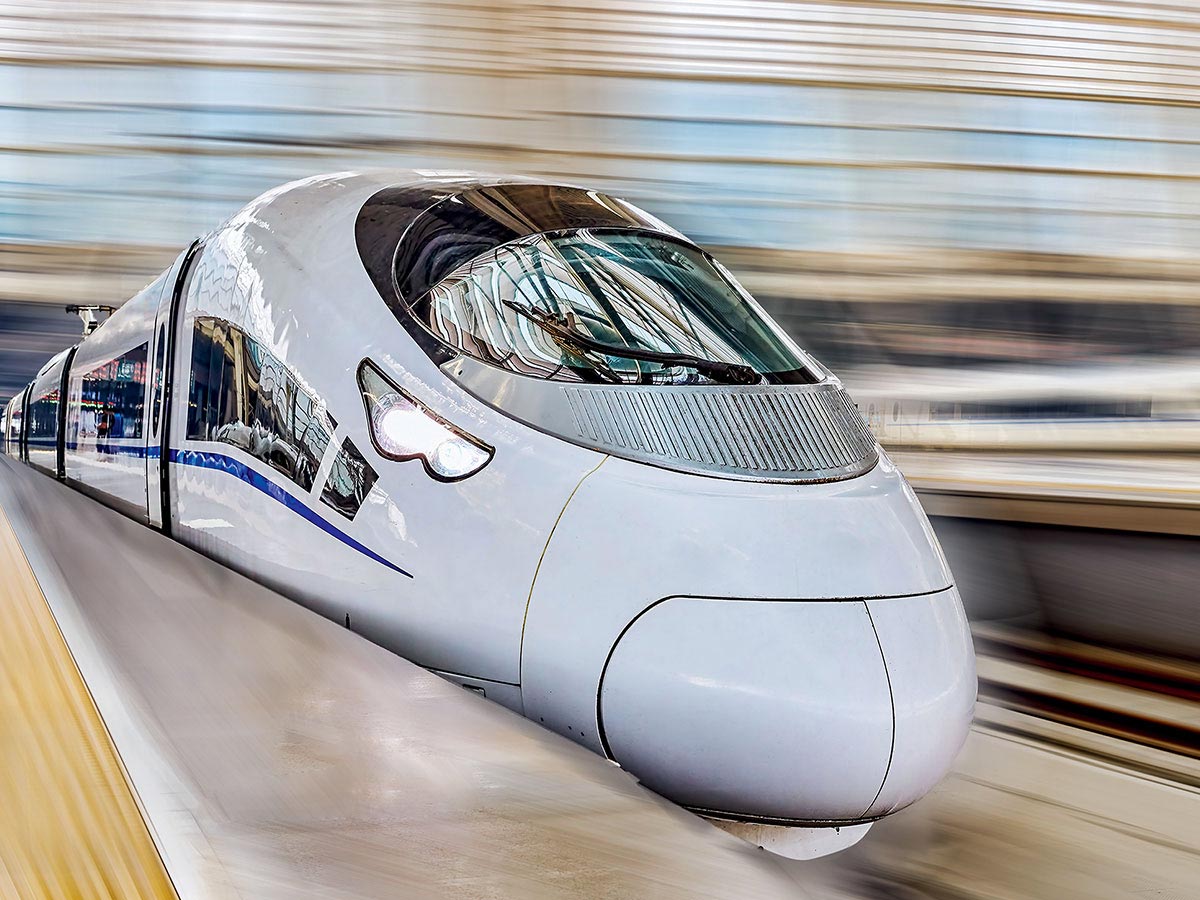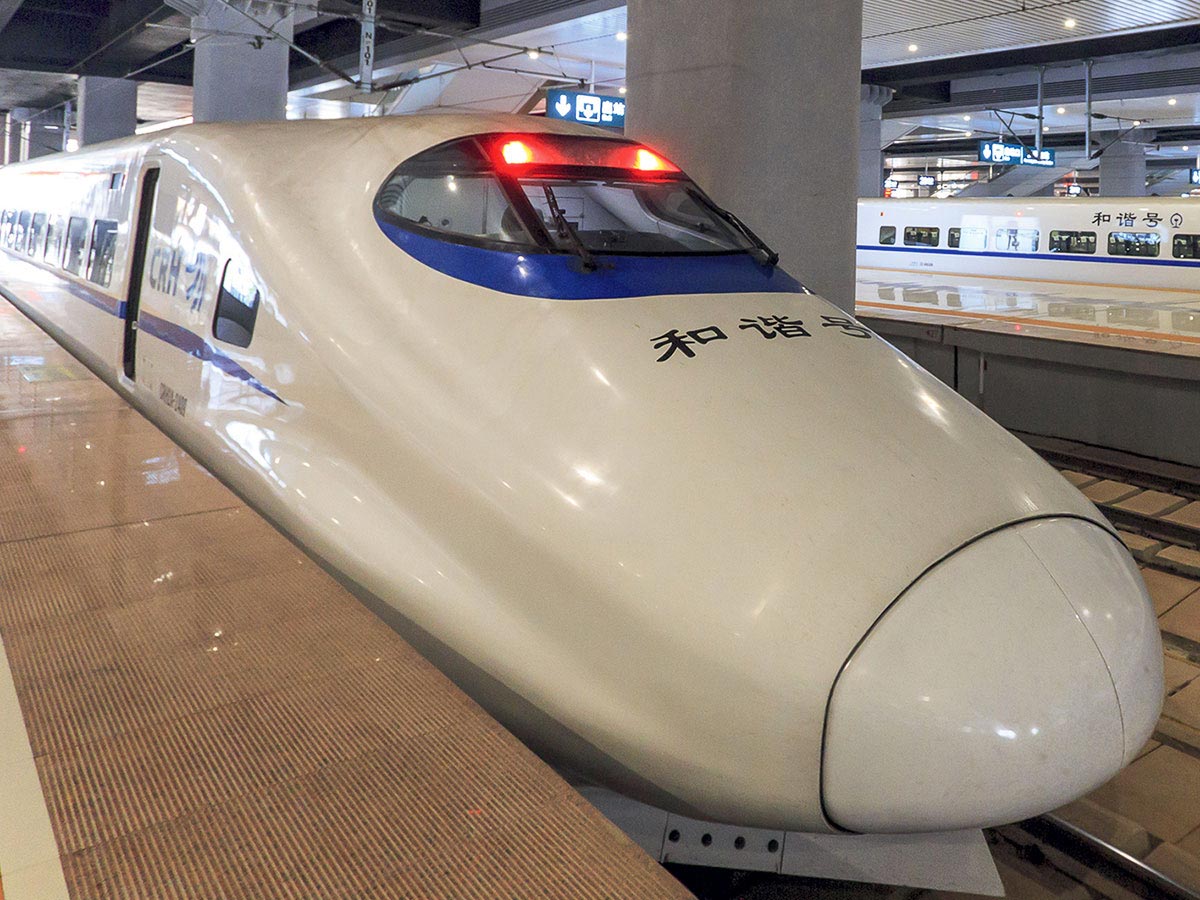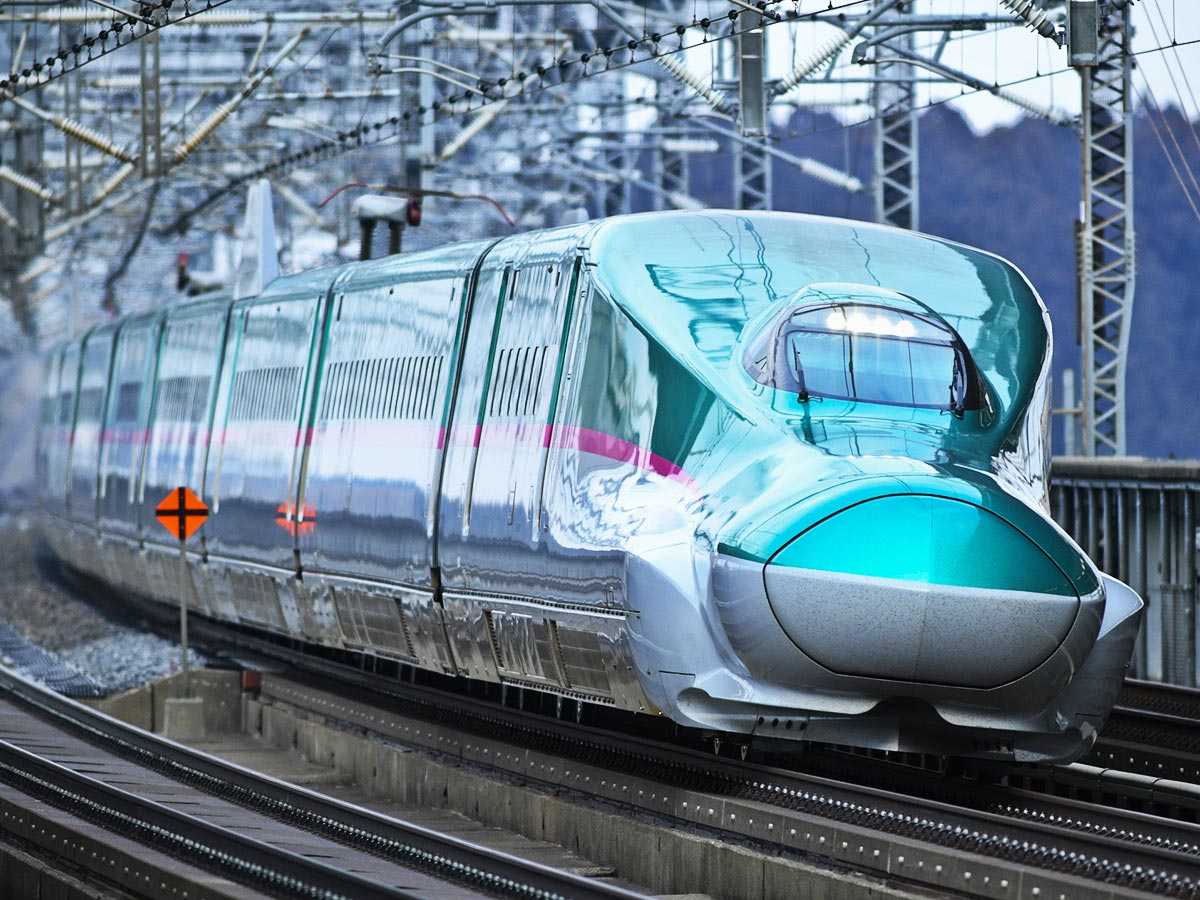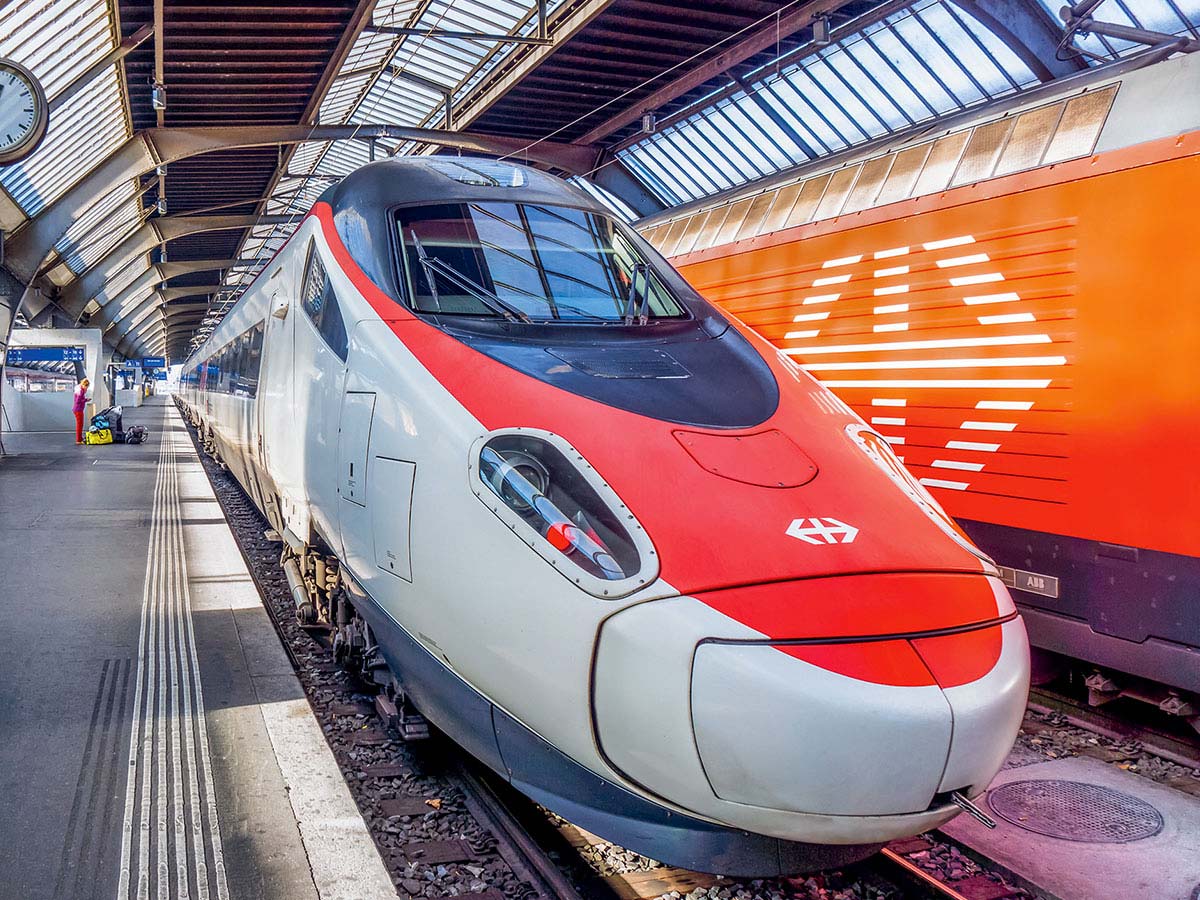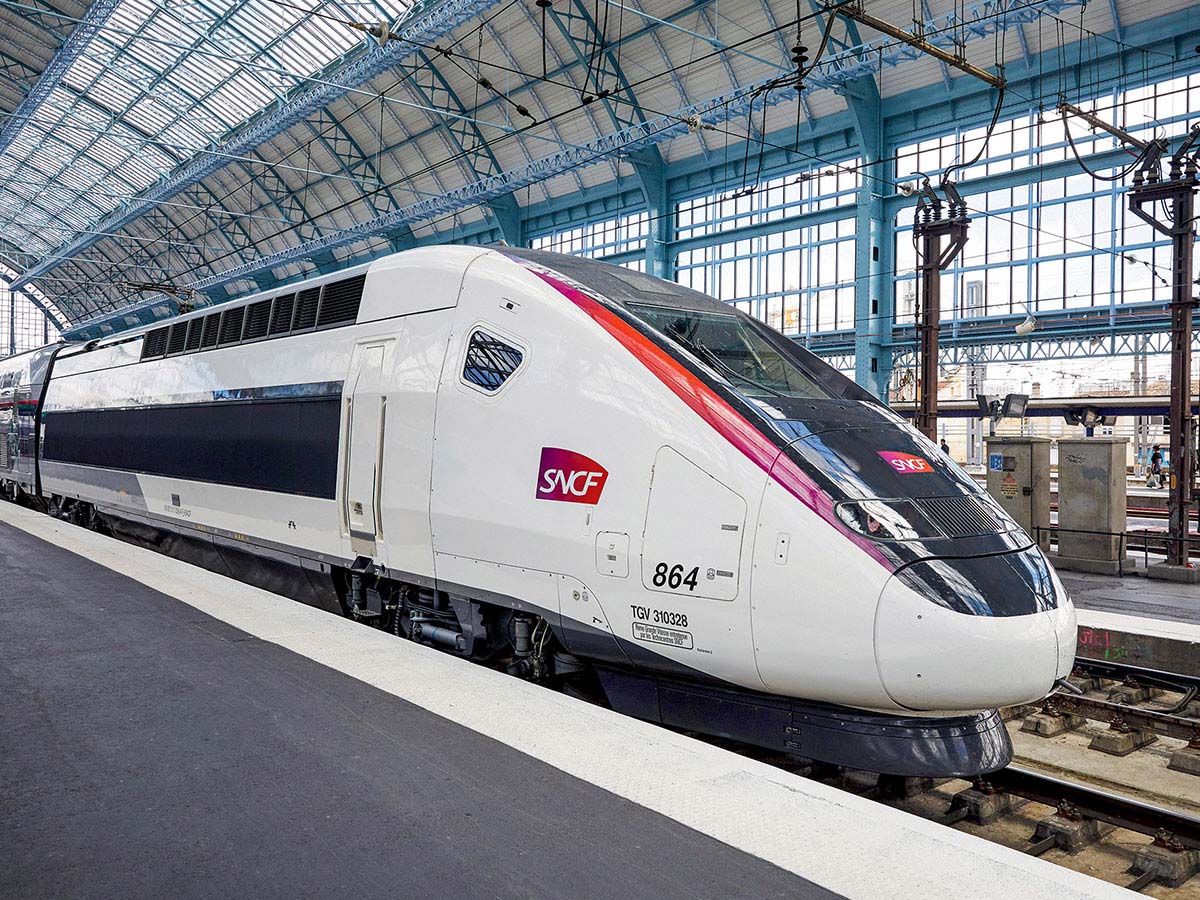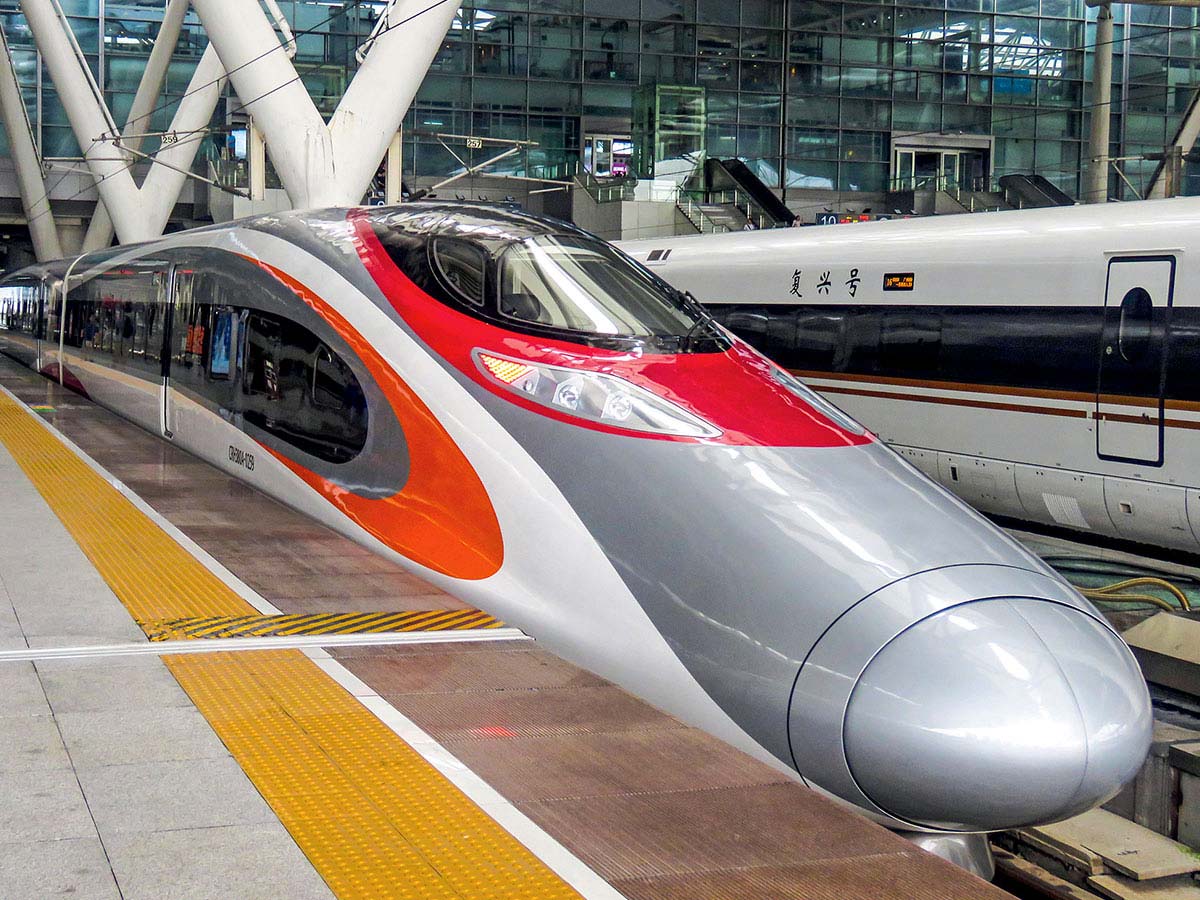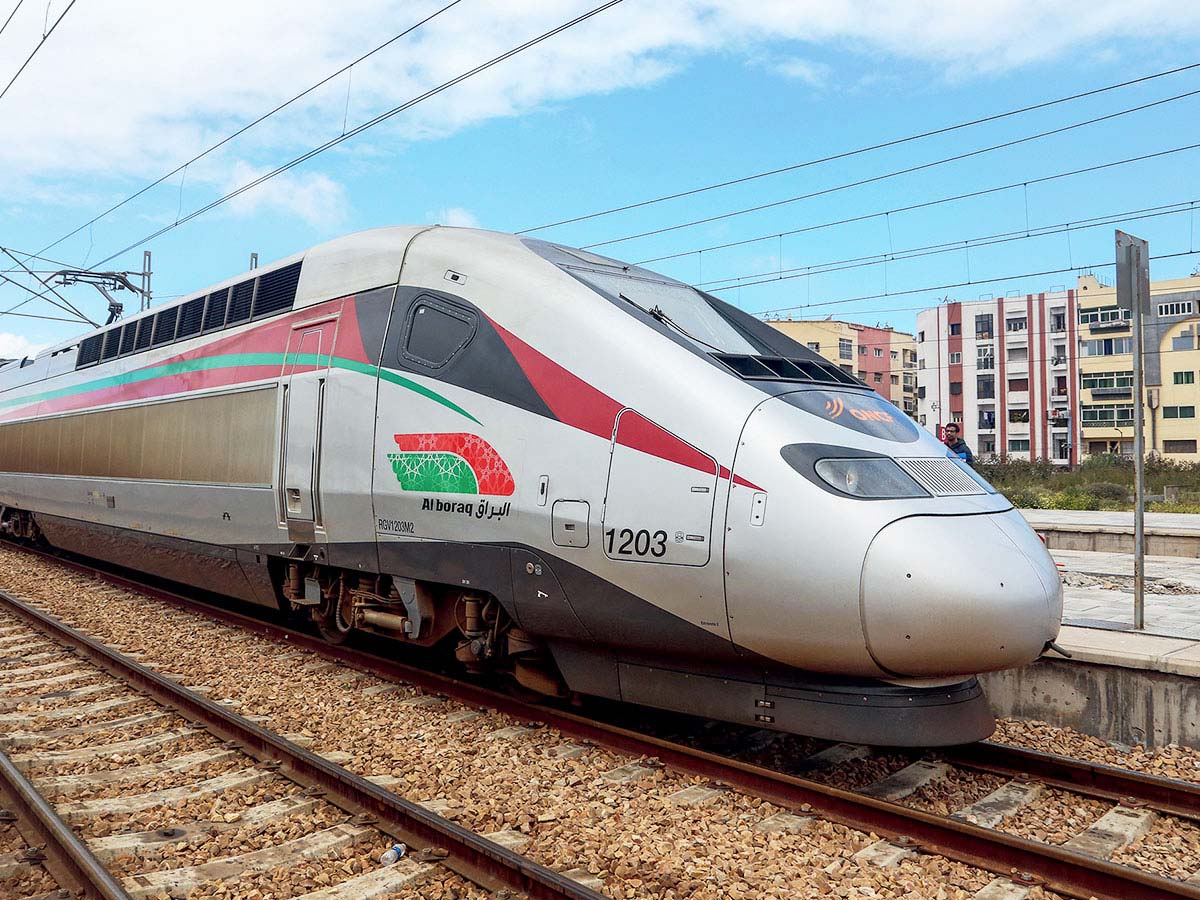MADRID > SEVILLE

1992 | SPAIN
Journey
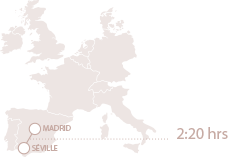
More Info
- Length in km: 470 km
- Name of the train: AVE
Madrid and Seville. The first is creative, multicultural, one of the great capital cities of Europe. The second represents the festive and colourful essence of Andalusia. Spain occupies the most southwestern corner of the European continent, and over the past thirty years has engaged in an exemplary process of infrastructure modernisation. In terms of rail, Spain made the courageous decision to build its first standard gauge high-speed line, at the time when the entire medium and long distance network was composed of wide-gauge and, in the Cantabria area, narrow-gauge tracks. On 21 April 1992, the inauguration of the Madrid-Seville line coincided with the opening of the Universal Exposition in Seville. Today, passengers travel between the two cities in two hours and twenty minutes.
Leaving Madrid
After Paris and London, Madrid is one of the most visited cities of Europe. Due to its geographical position at the heart of the Iberian Peninsula, the city has experienced many cultural influences. As the seat of Habsburg and later Borbón royalty, Madrid is host to prestigious architectural structures and monuments, and rich masterpieces line the walls of its legendary museums. Vibrant, attractive and modern, with its festive lifestyle and cultural scene, the city is known for its high-octane night life. The image of a “city that never sleeps” is well justified. Atocha is the largest rail station in the capital city, and with its multiple points of access, transforms each day into a well-organised beehive.
The older hall - dating back to the 19th century – is a destination in itself, with its brick walls and steel and glass coffer. Visitors discover an unexpected tropical paradise at the heart of the station, where a monumental greenhouse is home to four thousand trees and plants from five continents. The expansion and modernisation of Atocha Station, designed by Spanish architect Rafael Moneo in 1992, was driven by the arrival of the high-speed network. This new construction brought several buildings together under one roof, all contiguous to the historic hall.
The burden of railway heritage
There were many reasons for Spain to increase and accelerate investment in the creation of a modernised rail network. Dilapidated tracks could no longer meet the needs of the country’s growing economy. Gauges of different sizes were a reflection of the country’s history as well as an impediment to progress, forcing Spain into a position of rail isolation from the rest of the European continent, except Portugal. Indeed, the imperative to compete with the renovated national road network and to improve market position for the railway in an international context combined to impose a radical change in priority. Spain made the courageous decision to support rail, taking advantage of the exceptional opportunity offered by the European Regional Development Fund (ERDF), and benefitting from these subsidies to build a modern network equipped with standard gauging. Turning its back to conventional technology, Spain took a great leap forward to overcome the weak legacy of its national railways. After careful consideration, the major tourism axis of Andalusia was chosen to become the first destination for high-speed – or AVE (Alta Velocidad Española) – and the Madrid-Seville line was put into operation. Initially, the Spanish joined forces with the French to acquire rolling stock and with Germany for signalisation and electrification systems. Then, slowly but surely, Spain began to create its own railway industry, which has now developed its own high-speed trains by Talgo and CAF, including those able to operate automatically between variable-gauge tracks.
Madrid-Seville, the journey
Upon departure from Madrid, the train runs through the high plateaus of the Meseta, a plain surrounded by sierras. This is Castilla-La Mancha, the land of wide horizons immortalised by Don Quixote, the fictional hero created by Miguel de Cervantes. High winds are common in the region, and passengers may glimpse the famous windmills as the landscape unravels. Fields of wheat, covered in poppies at springtime, give way to olive groves and vineyards. In thirty minutes, the AVE passes near beautiful Toledo, on the banks of the Tagus River. Behind the rampart walls, churches, synagogues and mosques reveal the multicultural aspect of medieval Castilla. Designated as a Unesco World Heritage of Humanity Site, the city is laid out in sloping cobblestone streets that all lead to a stately Gothic cathedral.
The train stops at Ciudad Real and Puertollano, two stations built concurrently with the high-speed line. When the train reaches the first foothills of the Sierra Morena, it enters a series of viaducts and tunnels built to preserve the scenic Sierra de Cardoña y Montero Natural Park, where holm oaks stand alongside strawberry (arbutus), Mediterranean pine and olive trees. Continuing on, vineyards and olive groves herald Andalusia and the hills and valleys along the fertile banks of the Guadalquivir River. As the train nears Cordoba, passengers might observe several ruins, unaware that this archaeological complex was discovered during the construction of the Cordoba station, revealing little known vestiges of Spanish antiquity. The medieval city of Cordoba is a must see – its renowned mosque is considered one of the world’s greatest examples of Islamic architecture. Nestled alongside a nook of the Guadalquivir, the city is best discovered on foot, along narrow winding streets, past flowered patios and squares. Following its path on to Seville, the train passes below the proud fortress of Almodóvar del Rio, looking over the great river. All around is the rich Cordovan countryside, or campiña, known for its ancient olive groves. Seville heralds the end of the voyage.
In record time
The construction of new high-speed tracks required complex works, notably in terms of the equipment of rail stations with tracks, built specifically for the Spanish high-speed rail. In order to save travelling time, engineers created a route that is much more direct than the classic line, rendering possible access to cities once isolated such as Ciudad Real and Puertollano. The 105-kilometres-long section between Brazatortas and Cordoba presented the most challenging phase of construction. The line crosses the Sierra Morena mountains, so this section required many tunnels – 15 out of a total 17! – and half of all viaducts along the line. In order to facilitate wildlife mobility, 287 passages were dug underneath the track. Great efforts were undertaken to refurbish the surrounding environment after works were completed: reforestation with indigenous flora, treatment of river water, and more. During the excavation phase of the Cordoba rail station construction, vestiges of a monumental archaeological complex were discovered. The Cercadilla site revealed a Roman palace with its majestic semi-circular crypto portico and other edifices attributed to the emperor Maximianus Herculius.
Innovation
As a pioneer in the field of railway inter-operability applied to high-speed, Spain has resolved the problem of compatibility with conventional rail, thanks to an automatic variable gauge system. This enables trains to pass from a wide track to a standard track and vice versa. After operating rolling stock from Alstom, and later introducing Velaro trains by Siemens, Spain began to produce its own high-speed trains with standard gauge through Spanish railway equipment manufacturing companies Talgo and CAF.
The historical significance of this find, which dates back to the 3rd century, is remarkable. In Madrid, another feat of engineering is represented by the three “tunnels de la Risa” (tunnels of laughter), which provide an underground city link between Atocha and Chamartín stations. Two of these tunnels are dedicated to wide tracks with Iberian gauge, while the third, completed in 2019, connects the northern and southern high-speed lines. Above all others, the major challenge of the Madrid-Seville line was to respect a very tight project schedule. In order to coincide with the opening of the 1992 Universal Exposition in Seville, the entire line had to be completed in the record time of six years, though the decision had been taken in 1986!
Adif and Renfe
The Spanish railway system consists of two independent public companies: Renfe, the Spanish railway operator, and Adif, the Spanish infrastructure manager. Each possesses its own brand and logo. All high-speed trains circulating on the line belong to Renfe, while the rail stations are the property of Adif.
→ A Talgo crossing the Andalusian countryside.
The Talgo models
The aerodynamic profile of the Talgo 102 and 130 models, not unlike the Japanese Shinkansen train, has earned them the nickname pato, or “duck”. The Talgos are built of aluminium – chosen for its light weight -, and wear an elegant colour scheme of white, grey, and fuchsia. Thanks to its automatic axle gauge changing system, the 130 train runs on both standard gauge high-speed lines and classic wide-gauge lines. On the sides of the rail cars is the logo of AVE (Alta Velocidad Española), the Spanish high-speed rail transport brand. The logo features the silhouette of a bird, its wings extended above the letter V, symbolising speed itself. On-board and in-station services include baby care spaces and the 24-hour Atendo service, dedicated to attend to the needs of passengers with reduced mobility.
Prior to boarding the AVE trains, passengers pass the X-ray baggage control, then congregate in a waiting lounge before accessing the platform. This rigorous organisation ensures better management of station traffic flow as well as greater safety for travellers. Delays, however, are not tolerated. The punctuality and quality of on-board service set the Spanish high-speed trains apart. When passengers purchase tickets, they enter a contract with the railway company. Any delay lasting more than 15 minutes is reimbursed at 50%, and after 30 minutes at 100%. Uniformed staff is particularly attentive to passengers’ needs. In the Turista and Preferente classes of service, seats are oriented in the direction of travel, and complimentary headphones and screens are offered for video entertainment. In Preferente class, meal service is also offered to all travellers.
→ A Talgo high-speed train crossing the countryside between Madrid and Seville.
Arriving at Seville
The historic heritage and attractions of the Andalusian capital are legendary. It is a difficult task to see all the riches on offer in this city of winding streets, rising up from the banks of the Guadalquivir River. Visitors stroll from the immense Gothic cathedral to the Alcazar Palace, the slender silhouette of the Giralda to the vast and elegant Torre del Oro or the charming Jewish quarter of Santa Cruz. Major events take place all year long: the solemn Semana Santa, or Easter, the festive Feria de Abril, the “corridas” in La Maestranza. During these celebrations, the Santa-Justa station, north of the city centre, is bursting with excitement. Visitors pour out of the high-speed trains arriving from Madrid. Seville is the end of line, and the station’s hall fills with black-clad women coiffed with mantillas and young girls in flounced flamenco dresses of every colour. These festivals mark peak travel times, and between events the station is calm once again, impressive in both size and scale.
The inauguration of the station in 1992 coincided with the opening of the Madrid-Seville line as well as the Universal Exposition. A web of escalators, ramps and passageways facilitates arrivals and departures, and an elegant wave-shaped awning shelters train platforms. The concourse is home to a selection of boutiques, snack bars and restaurants, and hosts a variety of events throughout the year.
→ Plaza de España in Seville.
A greater mobility
The Madrid-Seville line has changed the travelling habits of the Spanish public: most air traffic has been transferred to the AVE. 60% of travellers who take the train between Madrid and Seville do so for business, 20% for leisure, and another 20% for family reasons. Since 1992, this line has significantly increased Spaniards’ mobility, including the connections between high-speed lines and classical lines to Málaga (from Cordoba), Cadiz and Huelva. It has also produced a dynamic effect on smaller cities such as Ciudad Real and Puertollano, each of which now boasts its own station. Ciudad Real, only one hour from Madrid, is attracting 26% of passenger traffic, which has proven to be an economic boost for the city. In these two cities, hotel projects and other commercial activities have developed, and many new residential complexes are springing up around the stations.
a selection of HIGH-SPEED LINES by creation date
1964

TOKYO > OSAKA
1992

TURIN > NAPLES
1992

MADRID > SEVILLE
2002

COLOGNE > FRANKFURT
2008

BARCELONA > MADRID
2010

SEOUL > BUSAN
2011

BEIJING > SHANGHAI
2014

ANKARA > ISTANBUL
2014

LANZHOU > URUMQI
2016

SHANGHAI > KUNMING
2016

TOKYO > HAKODATE
2016


ZURICH > MILAN
2018

BEIJING > HONG KONG
2018

TANGIER > CASABLANCA






